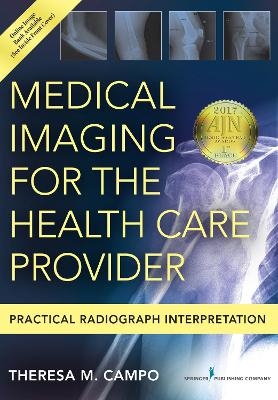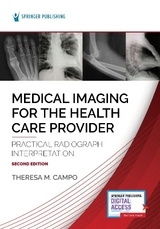
Medical Imaging for the Health Care Provider
Springer Publishing Co Inc (Verlag)
978-0-8261-3126-3 (ISBN)
- Titel erscheint in neuer Auflage
- Artikel merken
This resource describes and compares available diagnostic modalities, including plain radiograph, CT scan, nuclear imaging, MRI, and ultrasound. It discusses pediatric considerations and includes separate chapters for the chest, abdomen, upper and lower extremities, and the cervical, thoracic, and lumbar spine. The book will be an asset to nurse practitioners and physician assistants working in all emergency, urgent, intensive, and primary care settings. It will also benefit medical students and graduate students in acute care, family, adult/gerontology, and emergency nurse practitioner programs, as well as emergency/trauma clinical nurse specialists, and hospitalists and intensivist nurse practitioners.
Key Features:
Integrates the basics of radiology, CT scans, nuclear imaging, MRIs, and ultrasound, their characteristics and differences among testing modalities, and basic step-by-step interpretation skills
Relevant to a wide range of nurse practitioners, physician assistants, and other mid-level providers in multiple settings
Includes a step-by-step guide to the interpretation of the radiographs
Delivers an easy-to-understand approach to selecting diagnostic imaging tests
Presents actual images and figures to demonstrate concepts, which are also available digitally
Theresa M Campo DNP, APRN, FAANP, FAAN is Chair of the Department of Emergency Medical Services (EMS) and the Director of the Emergency Nurse Practitioner Track as well as Associate Clinical Professor at Drexel University. Clinically, she is board certified as a Family Nurse Practitioner and Emergency Nurse Practitioner, and works part-time as a nurse practitioner in Southern New Jersey. Theresa received her Doctor of Nursing Practice from Case Western Reserve University in Cleveland, Ohio. She earned her Master of Science in Nursing, Family Nurse Practitioner, from Widener University in Chester Pennsylvania. Theresa has over 30 years of experience in emergency medicine, including pre-hospital, emergency department/quick care, and trauma. Dr. Campo is a founding Board Member of the American Academy of Emergency Nurse Practitioners, a national organization. She is a national and international lecturer on emergency and urgent care topics. Dr. Campo is the Author of, "Medical Imaging for the Health Care Provider: Practical Radiograph Interpretation" and has authored several book chapters and peer-reviewed articles. Theresa was inducted as a Fellow of the American Association of Nurse Practitioners (AANP) in 2015 and Fellow of the American Academy of Nursing in 2017. She has received the alumni award for excellence from Case Western Reserve University and the state award of excellence from AANP.
Contents
Reviewers
Foreword by David Begleiter, MD
Preface
Acknowledgments
Unit I: Introduction to Medical Imaging Including Radiographs, CT, Nuclear Scans, MRIs, and Ultrasonography
1. Radiology Basics
History of Radiology
Factors Affecting Images
Conclusion
Resources
2. Radiating Testing Modalities
Radiographs
Computed Tomography (CT)
Nuclear Scanning
Conclusion
Resources
3. Nonradiating Testing Modalities
Magnetic Resonance Imaging (MRI)
Ultrasonography
Considerations When Ordering Diagnostic Medical Imaging
Conclusion
Resources
Unit II: Interpreting Chest and Abdominal Radiographs
4. Basic Interpretation of the Chest
Radiographic Densities
Adequacy of Radiographs
Pediatric Considerations (Comparison of Adult and Infant/Child)
Mediastinal Width
Conclusion
Resources
5. Abnormalities Found on Radiographs of the Chest
Atelectasis
Pulmonary Edema
Pleural Effusion
Interpretation of Infiltrates and Consolidation
Pneumothorax
Tension Pneumothorax
Pneumomediastinum
Hyperaeration
Masses and Tumors
Conclusion
Resources
6. Basic Interpretation of the Abdomen
Interpretation and Normal Findings
Free Air and Air–Fluid Levels
Calcifications
Foreign Bodies
Dilated Small Bowel
Dilated Large Bowel and Megacolon
Conclusion
Resources
Unit III: Interpretation of Extremity Radiographs
7. Basic Interpretation of Long Bone—Upper Extremity Radiographs
Normal
Abnormalities of the Upper Extremity
Bone Lesions
Conclusion
Resources
8. Basic Interpretation of Long Bone—Lower Extremity Radiographs
Normal
Describing Fractures
Pediatric Considerations
Abnormalities of the Lower Extremity
Conclusion
Resources
Unit IV: Interpretation of Spine Radiographs
9. Basic Interpretation of Cervical Spine Radiographs
Normal
Abnormalities
Conclusion
Resources
10. Basic Interpretation of Thoracic Spine Radiographs
Normal
Abnormalities
Conclusion
Resources
11. Basic Interpretation of Lumbar Spine Radiographs
Normal
Abnormalities
Conclusion
Resources
Index
| Erscheinungsdatum | 31.12.2016 |
|---|---|
| Verlagsort | New York |
| Sprache | englisch |
| Maße | 178 x 254 mm |
| Themenwelt | Medizin / Pharmazie ► Gesundheitsfachberufe ► MTA - Radiologie |
| Medizinische Fachgebiete ► Radiologie / Bildgebende Verfahren ► Radiologie | |
| Pflege ► Fachpflege ► Anästhesie / Intensivmedizin | |
| Pflege ► Fachpflege ► Chirurgie / OP-Pflege / Orthopädie | |
| Studium ► 2. Studienabschnitt (Klinik) ► Anamnese / Körperliche Untersuchung | |
| ISBN-10 | 0-8261-3126-3 / 0826131263 |
| ISBN-13 | 978-0-8261-3126-3 / 9780826131263 |
| Zustand | Neuware |
| Informationen gemäß Produktsicherheitsverordnung (GPSR) | |
| Haben Sie eine Frage zum Produkt? |
aus dem Bereich



